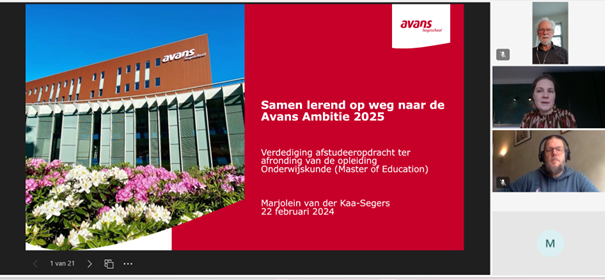Today, Marjolein van der Kaa successfully defended her thesis for the Master of Education. This announcement is written in English although the thesis is in Dutch. However, the theme, approach and outcomes of this signature work are important for al higher education, internationally, as it touches upon an essential innovation which revolves around curriculum redesign in the direction of outcome-based, competence-oriented, flexible education.
The graduation project was conducted within Avans University of Applied Sciences in the Netherlands. The title of the project was ‘Together, Learning towards the Avans Ambition 2025’. As will be clear, this title stresses the fact that Avans puts a lot of emphasis on cooperative work to design and implement all education programs in the organization. The organization realizes itself that embodying the new educational philosophy regarding agile and resilient professionals for a sustainable future, requires ample faculty development is necessary.
The new educational model of Avans uses the work on Backward Design and Constructive Alignment, and with these modular, coherent and complete programs have been designed in which authentic professional questions (products, services, outcomes, etc.) were included, with a maximum of three learning outcomes per module (there are around 16 modules per program), in which knowledge, skills and attitudes were integrated. Furthermore principles of formative performance were included.
In this process of educational change, the teaching faculty’s role of designer was seen as instrumental, and as a consequence a process of faculty professional development was initiated. The goals of the faculty development process was to improve the performance of faculty in their role of designers and implementers of redesigned teaching programs (modules).
The design process took two months, and the implementation process as well. Components of the development process were 1. The formulation of learning outcomes; 2. The design of assessment strategies; 3. Mapping necessary knowledge, skills and attitudes; 4. Design of suitable learning activities; 5. Designing arrangements for formative behavior for teaching and learning; 6. Design a feedback process.
A series of meetings was held (with the program team of Accountancy), based on the principles of Teacher Design Teams, in which cooperative faculty learning was intertwined with the design and pilot-testing of the modules.
The results of the design and implementation process were evaluated, using the following mix of research methods: evaluation meetings, log book analysis, observations, document analysis, and evaluation meetings.
The conclusion of the thesis work was that a Teacher Design Team in which Design Thinking was used, using principles of Backward Design and Constructive Alignment, is an effective method to arrive at improved performance of faculty during module development in which formative assessment is included.
As a result of this thesis project, a series of recommendations were formulated: 1. Keep using the principles of Teacher Design Teams and Design Thinking. 2. Be sure to let faculty who design modules also implement them; 3. Arrange for adequate instructional coaching; 4. Arrange for a sufficient amount of time for development; 5. Check the motivation of faculty for the agreed educational change before planning the design and implementation process; 6. Share constructed knowledge and experience; 7. Provide a toolbox with examples of previously developed instructional methods, educational formats and learning materials; 8. Make descriptions of best practices and make these available for other program teams.
A toolbox was created as a professional product (outcome) of this thesis project. The toolbox consists of a PPT-file of 83 pages, in which all step of the design and implementation process are elaborated. Program teams can use this to guide their module design and implementation practices. Congratulations Marjolein with this interesting thesis, the practical results and useful guidelines.

